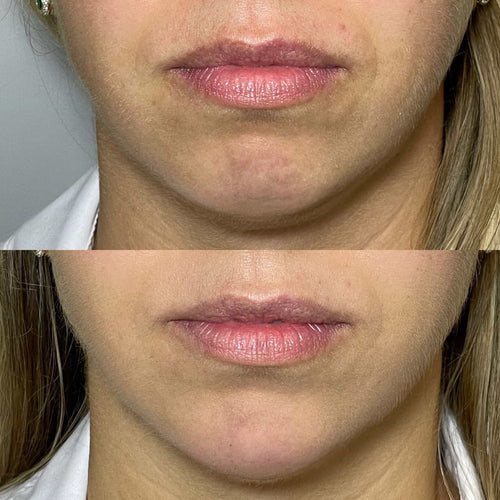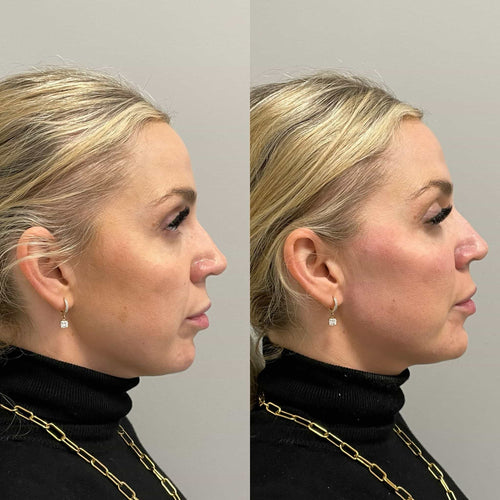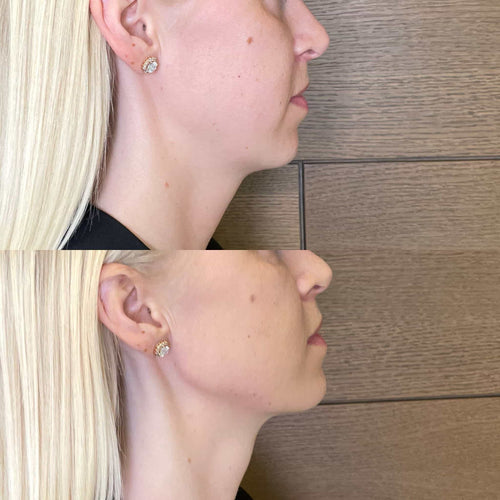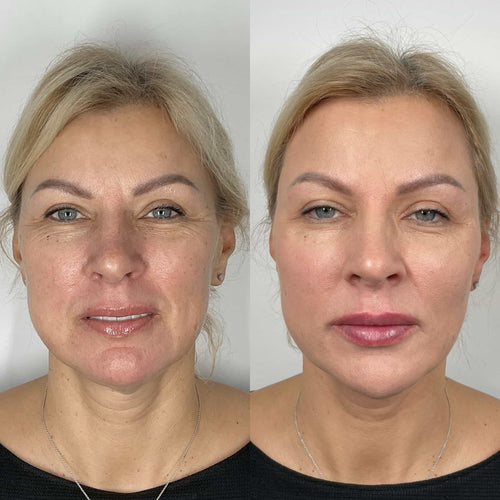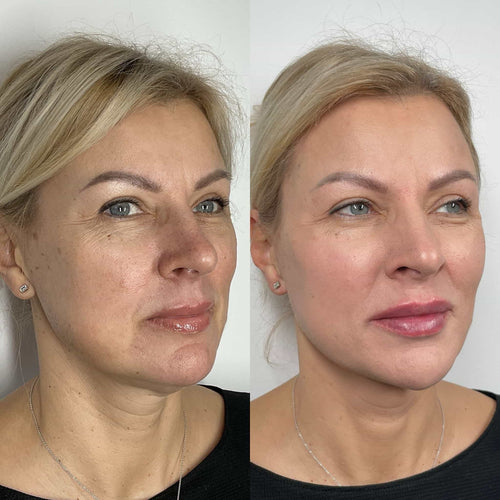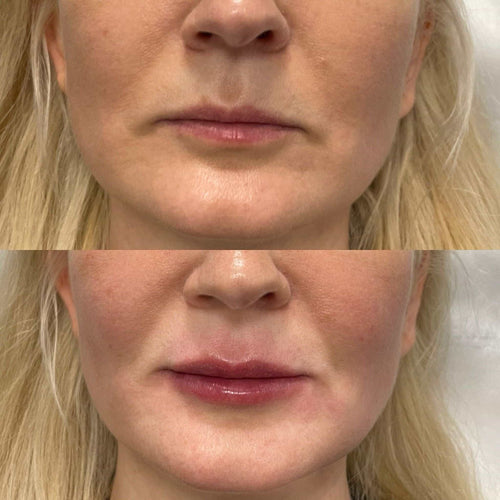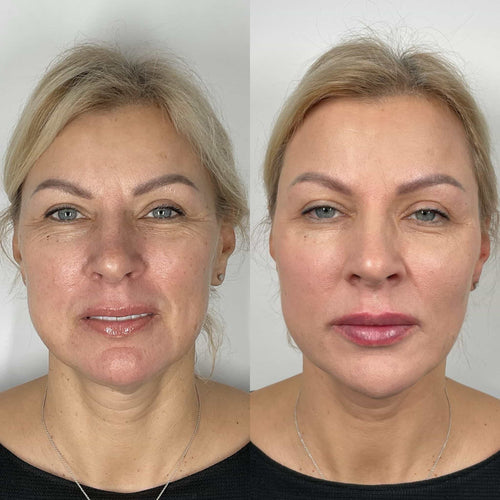Schedule Your Dermal Filler Appointment at It’s Me and You Clinic with Dr. Laura Geige
Potential Complications
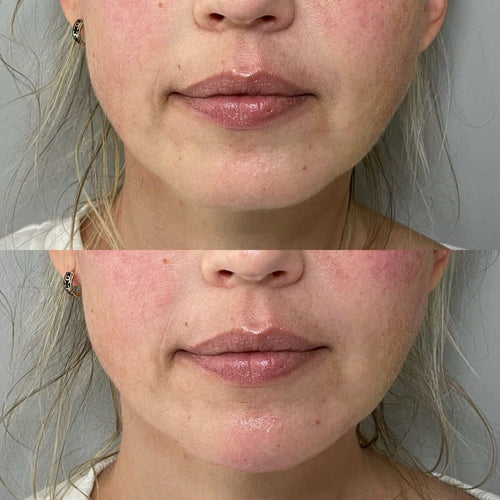
Infection
Book Your Dermal Filler Appointment with Dr. Laura Geige Now
Potential complications from any dermal filler injection, including those targeting the nasolabial folds, are possible, although most patients experience satisfactory results.
Here’s a breakdown of potential complications, with particular attention to infection:
- Infection: While rare, infection is a risk with any invasive procedure. Signs of infection include redness, swelling, pain, warmth, and discharge from the injection site. If you notice these symptoms, seek medical attention immediately.
- Vascular Occlusion: This occurs when a blood vessel is blocked by the filler, potentially leading to tissue damage. It’s crucial to have this procedure performed by a trained professional who understands proper injection techniques and anatomical landmarks to minimize this risk.
- Lumpiness or Nodules: Uneven distribution of filler can cause visible lumps or nodules under the skin. This can often be addressed with further treatment, such as massage or hyaluronidase (an enzyme that breaks down hyaluronic acid fillers).
- Asymmetry:**
- Migration: Filler can sometimes move from its intended location, causing unexpected results.
- Allergic Reaction:** Although uncommon, allergic reactions to the filler material can occur.
- Choose a qualified and experienced injector who follows strict sterilization practices.
- Ensure the facility is clean and adheres to proper infection control protocols.
- Avoid touching or picking at the injection site.
- Wash your hands thoroughly before and after touching the area.
- If you experience any signs of infection, seek medical attention promptly.
- Infection: Like any injection procedure, there’s a risk of infection at the injection site. Symptoms may include redness, pain, swelling, and pus discharge. Prompt medical attention is crucial if an infection occurs.
- Allergic reaction: Some individuals may experience an allergic reaction to the filler material. This can manifest as itching, hives, swelling, or difficulty breathing. In severe cases, anaphylaxis (a life-threatening allergic reaction) can occur.
- Vascular occlusion: If filler is accidentally injected into a blood vessel, it can block blood flow, leading to tissue damage or necrosis (death). This is a rare but serious complication that requires immediate medical intervention.
- Asymmetry: Uneven injection can result in an asymmetrical appearance, with one side appearing more filled than the other. Proper technique and communication with the injector are crucial to minimize this risk.
- Granuloma formation: In rare cases, the body may form a small, noncancerous lump (granuloma) at the injection site as a reaction to the filler material.
- Lumps and bumps: The filler may not be evenly distributed, leading to visible lumps or bumps. These can often be massaged away or smoothed out with further injections.
- Asymmetry: This is one of the most common concerns with NLF fillers. Even experienced injectors can struggle to achieve perfect symmetry, as facial anatomy naturally varies between individuals. Subtle asymmetries are often undetectable, but more pronounced ones can be noticeable and disappointing.
- Lumpiness or Nodules: If the filler isn’t injected smoothly or in adequate increments, it can clump together, creating lumps or nodules under the skin. This can affect both aesthetic appearance and comfort.
- Migration: Dermal fillers are designed to stay in place, but sometimes they can migrate from their intended location. This can occur if the filler isn’t injected deep enough or if the patient experiences significant facial movement or trauma.
- Vascular Occlusion: Injecting filler too close to a blood vessel can potentially block blood flow, leading to tissue damage (tissue necrosis). This is a rare but serious complication that requires immediate medical attention.
- Infection: Any injection carries a risk of infection, though this is generally low with proper sterilization techniques and aftercare.
- Allergic Reaction: Although rare, some individuals may be allergic to the ingredients in dermal fillers. Symptoms can range from mild redness and swelling to more severe anaphylaxis.
- Overcorrection or Over-Filling: Injecting too much filler can lead to an unnatural, overfilled appearance. This can often be corrected with hyaluronidase (an enzyme that breaks down hyaluronic acid), but in some cases may require surgical intervention.
-
Thoroughly research the procedure and its potential complications.
-
Discuss your medical history, medications, and allergies with a qualified practitioner.
-
Follow pre-injection instructions carefully, such as avoiding blood thinners.
-
Avoid smoking and alcohol consumption before and after the procedure.
-
Board certification: Verify that the practitioner is board-certified by a recognized medical organization.
-
Experience: Inquire about the practitioner’s experience with nasolabial fold fillers and other cosmetic procedures.
-
Credentials: Check for licenses, certifications, and any disciplinary actions against the practitioner.
-
Consultation: Schedule a thorough consultation to discuss your goals, concerns, and expectations. A good practitioner will listen attentively, answer your questions honestly, and provide realistic outcomes.
-
**Fillers** do not address underlying causes of aging, such as collagen loss or skin laxity.
-
They provide temporary results that typically last 6-18 months depending on the type of filler used and individual factors.
-
Results are gradual and may require multiple treatments to achieve desired fullness.
Schedule a Dermal Filler Session with Dr. Laura Geige
If the filler is not evenly injected, it can result in an asymmetrical appearance.
Careful assessment and skilled injection are essential to avoid this complication.
Preventing Infection
Swelling and Bruising
Potential complications associated with nasolabial fold fillers can range from minor and temporary to more serious and long-lasting. While most patients experience positive outcomes, it’s essential to be aware of these risks before undergoing the procedure.
Swelling and bruising are common side effects that typically subside within a few days to a week post-treatment. However, in some cases, they can persist longer or be more pronounced than expected.
Potential Complications
It’s important to consult with a qualified and experienced injector to discuss your individual risk factors and expectations for treatment. A thorough assessment will help determine if nasolabial fold fillers are right for you and minimize the likelihood of complications.
Asymmetry
Potential complications from dermal filler injections in the nasolabial folds (NLF) can range from mild and temporary to serious and permanent.
Here’s a breakdown of some potential issues:
It’s important to note that the risk of complications varies depending on factors such as the specific type of filler used, the experience and skill of the injector, and the individual patient’s health and medical history.
Addressing Issues
Dilution of Filler
Addressing issues related to filler dilution within nasolabial folds requires a multifaceted approach that considers both preventative measures and corrective actions.
Prevention starts with proper patient selection, thorough consultation, and meticulous injection technique. Selecting the appropriate filler type with optimal viscosity is crucial. A hyaluronic acid (HA) filler designed for deep lines is generally preferred for nasolabial folds. The injector must carefully assess the patient’s anatomy, understanding the depth and width of the fold to determine the correct amount and placement of filler.
During injection, using a blunt-tipped cannula can minimize trauma and distribute the filler evenly. Spreading the filler gradually along the nasolabial fold helps to create natural contours and reduce the risk of clumping or displacement. Avoiding overcorrection is essential, as excessive filler can lead to an unnatural appearance and increase the likelihood of migration.
If dilution does occur, several options are available for correction. The first step is usually observation. Mild diffusion might resolve on its own within a few weeks as the body naturally reabsorbs some of the filler.
Dissolving agents like hyaluronidase can be used to break down the HA filler and reverse the effects of dilution. This process requires careful administration by an experienced injector to avoid complications like bruising or swelling.
In cases where hyaluronidase is not effective or appropriate, alternative solutions might include strategically injecting additional filler to restore volume and definition, or using a different type of filler with higher density.
Ultimately, the best approach for addressing filler dilution depends on the individual patient’s situation. A thorough assessment by a qualified injector is crucial to determine the most effective course of action.
Dissolution Agents
Addressing issues related to dermal fillers, specifically those placed in the nasolabial folds, requires a multifaceted approach that considers both the nature of the issue and the underlying cause.
Dissolution agents play a crucial role in rectifying complications arising from dermal filler placement. Hyaluronic acid (HA) fillers, commonly used in the nasolabial folds, are readily dissolved with hyaluronidase, an enzyme that breaks down HA molecules.
Identifying the specific problem is paramount before employing any dissolution technique. Common issues include asymmetry, migration, or overcorrection, each demanding a tailored approach.
Asymmetry often necessitates a subtle adjustment of filler volume on one side to achieve balance. Migration may require careful removal and repositioning of the filler, while overcorrection might involve partial or complete dissolution followed by strategic re-injection.
The decision to dissolve all or partially depends on the extent and nature of the problem. Complete dissolution might be necessary for severe cases of asymmetry or migration where the filler has caused significant distortion.
Partial dissolution allows for a more nuanced correction, especially in cases of overcorrection where restoring natural contours is desired. Careful assessment by an experienced injector is essential to determine the optimal dissolution strategy.
The procedure itself involves injecting hyaluronidase directly into the affected area. The enzyme begins breaking down the HA filler immediately, resulting in gradual softening and reabsorption of the product.
While generally safe, hyaluronidase injections can cause temporary side effects such as swelling, bruising, and pain at the injection site.
Post-dissolution care involves monitoring for any adverse reactions and following specific instructions provided by the injector to minimize risks and ensure optimal healing.
Ultimately, addressing issues with nasolabial fold filler requires a personalized approach that combines careful assessment, appropriate dissolution techniques, and attentive post-treatment care.
Massage Techniques
Addressing issues arising from nasolabial fold filler injections requires a multifaceted approach that combines assessment, intervention, and patient education.
A thorough evaluation by a qualified medical professional is crucial to determine the nature of the problem. Potential issues include asymmetry, lumpiness, migration, overfilling, vascular occlusion, or infection.
Depending on the specific concern, various massage techniques can be employed to alleviate discomfort and potentially improve outcomes. These techniques are generally performed gently and cautiously by a trained professional to avoid further damage.
Manual lymphatic drainage is often used to reduce swelling and promote lymphatic fluid circulation, aiding in the dispersal of filler if it has migrated or pooled.
Deep tissue massage can be helpful for breaking up lumps or nodules caused by improper filler distribution. This technique involves applying sustained pressure to targeted areas to soften and disperse the filler.
Effleurage, a light stroking motion, can help to smooth out unevenness and contour irregularities.
It is important to note that massage should not be used to forcefully remove or dissolve the filler.
In cases of vascular occlusion or infection, immediate medical attention is required.
For patients experiencing discomfort or dissatisfaction with their results, a detailed discussion with their injector can help manage expectations and determine appropriate next steps. This may involve dissolving the filler with hyaluronidase, a specialized enzyme, or waiting for it to naturally metabolize over time.
Prevention is key in minimizing complications from nasolabial fold filler injections. Choosing an experienced injector who uses high-quality products and follows proper injection techniques is essential.
Patients should also carefully review the risks and benefits of the procedure beforehand and understand the potential for side effects and complications.
Prevention is Key
Choosing a Qualified Practitioner
When considering any cosmetic procedure, including nasolabial fold filler injections, prevention and choosing a qualified practitioner are paramount.
Prevention involves understanding potential risks and taking steps to minimize them. Here’s what you can do:
Choosing a qualified practitioner is crucial for ensuring safety and optimal results. Look for these qualities:
Remember, prevention and choosing a qualified practitioner can significantly reduce the risk of complications and help ensure a positive experience with nasolabial fold filler injections.
Understanding Your Skin Type
Prevention is key when it comes to maintaining healthy skin and minimizing the need for cosmetic procedures like nasolabial fold fillers.
Understanding your skin type is fundamental to a successful skincare routine. There are five main skin types: normal, oily, dry, combination, and sensitive.
Normal skin is balanced with minimal visible imperfections. Oily skin produces excess sebum, leading to a shiny complexion and potential breakouts. Dry skin lacks sufficient oil production, resulting in flakiness and tightness. Combination skin exhibits both oily and dry areas, often with an oilier T-zone.
Sensitive skin is prone to irritation, redness, and allergic reactions. Properly identifying your skin type allows you to select skincare products tailored to its specific needs.
A consistent skincare regimen incorporating cleansing, exfoliation, toning, moisturizing, and sun protection is crucial for all skin types.
Sun damage is a major contributor to premature aging, including the formation of nasolabial folds. Daily use of sunscreen with an SPF of 30 or higher is essential.
Avoiding smoking and excessive alcohol consumption can also help preserve skin health. Smoking damages collagen and elastin fibers, leading to wrinkles and sagging. Alcohol dehydrates the skin, exacerbating dryness and fine lines.
Hydration from within is equally important. Drinking plenty of water helps maintain skin elasticity and plumpness.
While prevention plays a significant role in minimizing nasolabial folds, they are a natural part of aging for many people. If you do choose to consider fillers, consult with a qualified and experienced practitioner who can assess your individual needs and goals.
Realistic Expectations
Prevention is key when it comes to any cosmetic procedure, including nasolabial fold fillers. Choosing a qualified and experienced injector who understands facial anatomy and your desired outcome is crucial.
This professional will assess your individual needs, discuss realistic expectations, and recommend the appropriate filler type and placement for optimal results.
Realistic expectations are paramount to achieving satisfaction with any cosmetic procedure. It’s important to understand that fillers can enhance features, but they cannot completely erase wrinkles or create dramatic transformations.
Discussing your goals openly and honestly with your injector will help set realistic expectations and avoid potential disappointment.
Be aware of the limitations of fillers:
Proper aftercare is essential for maximizing results and minimizing potential complications. Following your injector’s instructions carefully regarding post-treatment care, such as avoiding strenuous activity, makeup application, or exposure to excessive heat or cold, can significantly reduce the risk of adverse effects.
Be mindful of potential side effects, which may include swelling, bruising, redness, or tenderness at the injection site. These are typically temporary and resolve within a few days.
In rare cases, more serious complications such as infection or vascular occlusion can occur. Seek immediate medical attention if you experience any concerning symptoms following treatment.
Mind Plus Motion Yummalicious Food The Fine Nanny Alkhemist LA

